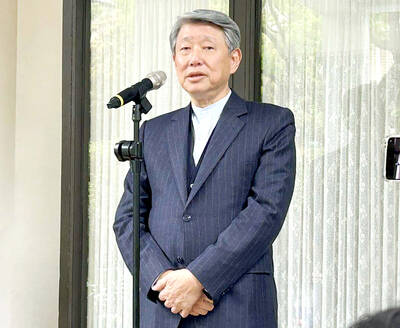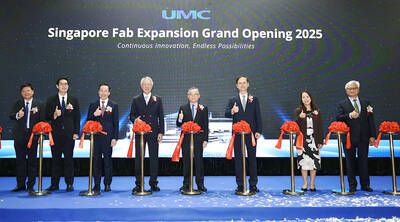Sony Corp shares yesterday fell the most in almost two years after the electronics maker missed profit estimates and forecast weaker sales and operating profits across most of its business units.
The stock fell 6.1 percent to ¥5,073 in Tokyo, the biggest one-day drop since June 2016 and the first trading session after last week’s earnings.
The move wiped out about US$4 billion from the company’s market value, while volume doubled the 180-day average.
Sales in Sony’s mobile, PlayStation, music, movies and home entertainment divisions are forecast to decline in the year to March next year, the Tokyo-based company said in a statement on Friday last week.
Only cameras, chips and financial services were seen improving slightly.
According to the outlook, operating profit is to decline to ¥670 billion (US$6.1 billion), less than analysts’ prediction for ¥747 billion.
Analysts expressed concerned over Sony’s weak outlook for smartphone camera chips, where it forecast a 39 percent decline in operating profit.
JPMorgan Chase & Co analyst J.J. Park lowered the firm’s price target for Sony from ¥5,400 to ¥5,200, telling investors to stay on the sidelines until shares finish adjusting to the weaker demand for smartphones.
“We expect Sony’s share price to follow the performance in Apple [Inc] supply chain names, which have shown a meaningful correction,” Park, Ky Oh and Hisashi Moriyama wrote in a note to clients on Saturday, in which they maintained their neutral rating on the stock. “We recommend that investors find a better entry point after a share price correction.”
Yesterday’s decline brought the gap between analyst price targets and the actual price to the widest since March 2016, data compiled by Bloomberg showed.
Sony CEO Kenichiro Yoshida needs to boost revenue by coming up with new products and services after five years of restructuring that he pushed through as chief financial officer with his predecessor, Kazuo Hirai.
While the changes have left Sony on solid footing, the company remains vulnerable to any potential downturn given that it is the top supplier for image sensors that go into the devices, including Apple’s iPhone.
Total operating profit was a record ¥735 billion for the year through March. Analysts were projecting an average of ¥743 billion.
Full-year sales rose 12 percent to ¥8.54 trillion.
“We’ve delivered on the promises we laid out and reached ¥500 billion profits in back-to-back years,” Sony chief financial officer Hiroki Totoki said at a news conference after the results. “Given we’ve never before achieved that, that accomplishment weighs very heavily on our shoulders, but that’s why it’s very important to continue to properly earn stable profits.”
SMARTPHONE WOES
Cooling demand for smartphones across markets is hitting Sony on two fronts: less demand for mobile camera chips and poor demand for Sony’s own models.
The Xperia division recorded a write-down and forecast an operating loss of ¥15 billion in the coming year.
The semiconductor unit would post a 39 percent decline in operating profit, Sony said, even though sales are seen climbing slightly.
“It’s not a great time for smartphones,” Asymmetric Advisors senior strategist Amir Anvarzadeh said in Singapore. “Sony has had phenomenal growth in the past few years, so it doesn’t take a genius to see that it will be harder to maintain from here on.”
Still, many investors remain optimistic, with Sony shares near 10-year highs.
A Bloomberg analysis of share price data suggested that chief financial officers turned CEOs tend to perform well.
In the 28 instances since the mid-1990s when large nonfinancial corporations promoted their finance chiefs to the top job, the stocks on average did twice as well as the broader market.
Sony shares were up about 6 percent before the results, following a 55 percent rally last year.
“Yoshida-san understands the stock market very well,” Bloomberg Intelligence analyst Masahiro Wakasugi said. “Expectations are as high as ever, but he’s the type who can probably respond to what the market wants.”
Operating profit at the chip unit was ¥164 billion in the latest fiscal year, better than Sony’s own estimate for ¥155 billion.
For the coming year, the company forecast a decline to ¥100 billion.
Sony said it was stepping up capital expenditure in the unit to ¥160 billion, of which ¥130 billion would be for image sensors.
Apple suppliers, including Sony, have been hit by poor demand for the iPhone X. However, with some Chinese smartphone manufacturers, such as Huawei Technologies Co (華為), now outfitting models with three rear-facing cameras, demand for image sensors might hold up.
Full-year operating profit in the gaming division was ¥177.5 billion, missing Sony’s estimate for ¥180 billion. The company sold 19 million PlayStation 4s, matching its forecast.
In the coming year, it expects to generate ¥190 billion in operating profit, while PlayStation 4 sales would slow to 16 million.
The film unit had an operating profit of ¥41.1 billion on sales of ¥1.01 trillion, compared with Sony’s estimate for ¥39 billion and ¥1.02 trillion respectively.
The company sees operating profit remaining mostly flat at ¥42 billion, with revenue shrinking to ¥960 billion.
Sony had one of its strongest box office performances in years, announcing this month that the new Jumanji movie had become its highest-grossing film in history.

MULTIFACETED: A task force has analyzed possible scenarios and created responses to assist domestic industries in dealing with US tariffs, the economics minister said The Executive Yuan is tomorrow to announce countermeasures to US President Donald Trump’s planned reciprocal tariffs, although the details of the plan would not be made public until Monday next week, Minister of Economic Affairs J.W. Kuo (郭智輝) said yesterday. The Cabinet established an economic and trade task force in November last year to deal with US trade and tariff related issues, Kuo told reporters outside the legislature in Taipei. The task force has been analyzing and evaluating all kinds of scenarios to identify suitable responses and determine how best to assist domestic industries in managing the effects of Trump’s tariffs, he

TIGHT-LIPPED: UMC said it had no merger plans at the moment, after Nikkei Asia reported that the firm and GlobalFoundries were considering restarting merger talks United Microelectronics Corp (UMC, 聯電), the world’s No. 4 contract chipmaker, yesterday launched a new US$5 billion 12-inch chip factory in Singapore as part of its latest effort to diversify its manufacturing footprint amid growing geopolitical risks. The new factory, adjacent to UMC’s existing Singapore fab in the Pasir Res Wafer Fab Park, is scheduled to enter volume production next year, utilizing mature 22-nanometer and 28-nanometer process technologies, UMC said in a statement. The company plans to invest US$5 billion during the first phase of the new fab, which would have an installed capacity of 30,000 12-inch wafers per month, it said. The

Taiwan’s official purchasing managers’ index (PMI) last month rose 0.2 percentage points to 54.2, in a second consecutive month of expansion, thanks to front-loading demand intended to avoid potential US tariff hikes, the Chung-Hua Institution for Economic Research (CIER, 中華經濟研究院) said yesterday. While short-term demand appeared robust, uncertainties rose due to US President Donald Trump’s unpredictable trade policy, CIER president Lien Hsien-ming (連賢明) told a news conference in Taipei. Taiwan’s economy this year would be characterized by high-level fluctuations and the volatility would be wilder than most expect, Lien said Demand for electronics, particularly semiconductors, continues to benefit from US technology giants’ effort

‘SWASTICAR’: Tesla CEO Elon Musk’s close association with Donald Trump has prompted opponents to brand him a ‘Nazi’ and resulted in a dramatic drop in sales Demonstrators descended on Tesla Inc dealerships across the US, and in Europe and Canada on Saturday to protest company chief Elon Musk, who has amassed extraordinary power as a top adviser to US President Donald Trump. Waving signs with messages such as “Musk is stealing our money” and “Reclaim our country,” the protests largely took place peacefully following fiery episodes of vandalism on Tesla vehicles, dealerships and other facilities in recent weeks that US officials have denounced as terrorism. Hundreds rallied on Saturday outside the Tesla dealership in Manhattan. Some blasted Musk, the world’s richest man, while others demanded the shuttering of his